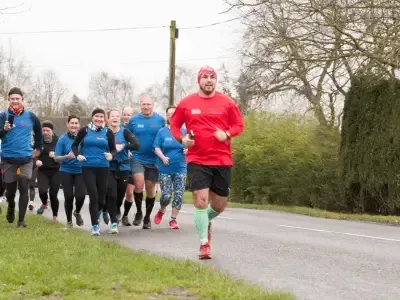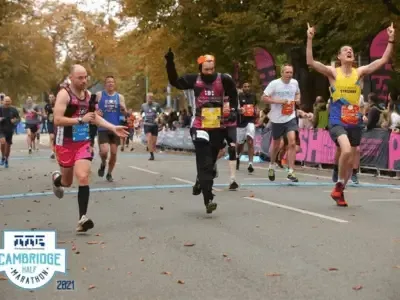Runpreneur Journey Blog
Embark on an extraordinary journey with the Runpreneur community. Discover inspiring stories, insider tips, and the transformative power of our global challenge. From first-time runners to seasoned athletes, our blog captures the essence of the Runpreneur movement, inspiring others to join the cause.

The Contradictory Concept of Paying My Children to Exercise: A Parental Experiment
The Contradictory Concept of Paying My Children to Exercise: A Parental Experiment
Today, I delve into a topic that's bound to raise a few eyebrows – paying my children to exercise. The idea might initially sound contentious, but hang in there, as I assure you there's a rational method to what might seem like madness.
Welcome back to day 1591 of my Runpreneur diary. If you're new here, my mission is to save children's lives by embarking on the ultimate ultra-marathon—run vlogging daily, covering the distance of a lap of the world barefoot. Your support through subscribing, sharing, liking and commenting amplifies our efforts in raising funds and awareness. More viewers mean more funds, which translates to more lives saved. So, thank you for being part of this journey.
Now, let’s jump into today’s topic: paying children to exercise. On the surface, it may appear worse than it is, so let me explain my reasoning. I have two of my kids—James and Maya—joining me today on bikes. Sometimes they run, but today's outing involves cycling. The crux of this idea is to impart the value of money to my children. At the age of 10, like my son James, or 12, like my daughter Maya, finding regular and suitable jobs to earn pocket money can be challenging.
I don't believe in giving pocket money without some form of effort. Gifts are reserved for birthdays or holidays, but everyday wants? Those need to be earned. My children help around the house with chores like making drinks, clearing up after dinner, taking out the bins, and hoovering. However, these tasks are often sporadic and lack the consistency necessary to teach them the real value of money.
One thing I value above all else is my children’s health. We maintain a healthy diet, and all my kids are active in sports, from football and basketball to gymnastics. Recently, running has also made it into the mix, albeit as a less favored activity. And guess what? Running is where my controversial idea comes into play.
I've devised a system where my kids earn money based on the distance they run or cycle with me. For instance, a mile of running or cycling could equate to 50p or £1. This way, if they have their eyes on something they want to buy, they know exactly how many runs or rides it will take to earn it. For instance, Maya, the newest runner, covers one to two miles, while James, a more seasoned runner, does two to three miles. Leo, my eldest, takes on longer distances regularly.
By setting a metric tied to their athletic efforts, I aim to instill commitment and consistency. They may not enjoy running, but their motivation is tangible, and the exercise becomes more purposeful. This approach also gives us valuable bonding time, making the runs more enjoyable and faster for me, while teaching them that money comes through effort.
James appears to appreciate this system. When he wants something but lacks enough money, he'll gladly run or complete a chore to earn it. This instils a sense of accomplishment in him. Maya's response, on the other hand, is more nuanced. While she finds it somewhat annoying, it still gets her moving on days she'd rather not.
I understand the importance of balancing this system to avoid spoiling my children. They don’t receive unearned money from me. Everything they get is through effort—either house chores or running with me. This is vital as it reflects real-world scenarios where one might not always enjoy their job but must do it to earn a living.
In conclusion, while paying children to exercise might not be everyone's cup of tea, if applied judiciously, it can teach valuable lessons about money and hard work. And, importantly, it keeps them active. Thank you for journeying with me on this run, both literally and metaphorically. Remember, supporting our mission saves more children's lives.
Stay positive, stay happy. Until next time, goodbye from Maya, James, and me.

Kevin's 40,075km Challenge: Raising £1 Million for Children
Meet Kevin, a dedicated Runpreneur who embarked on an extraordinary journey to raise £1 million for children in need. Over the course of his 40,075km challenge, Kevin's unwavering determination and passion inspired thousands to join the Runpreneur movement.

Runpreneur Vlogging: Capturing Kevin's Journey
Experience the Runpreneur challenge through the lens of Kevin's video diary. Witness his ups and downs, the camaraderie of the community, and the transformative power of running for a cause. Dive into the visual stories that capture the essence of the Runpreneur movement.

Empowering Children, One Step at a Time
As Kevin logged every kilometre of his 40,075km challenge, the true purpose behind his journey came into focus. Each step, each bead of sweat, fuelled essential healthcare, education, and nutrition programs for children in need around the world.

The Transformative 4x4x48 Challenge
Experience the thrill and personal growth of our iconic 48-hour running event. Witness the determination and resilience of Runpreneurs as they push their limits, one mile at a time.

Runpreneur Vlogging: Capturing the Journey
Dive into the visual stories of our Runpreneurs as they document their experiences through engaging video logs. Witness the challenges, triumphs, and moments of camaraderie that define the Runpreneur spirit.













